Marc Alston works for the U.S. EPA, Region 8 in Denver. He is on the Ecosystem Stewardship Team, and works in support of community-based environmental protection, with a focus on watershed protection groups.

Monday, 19 Jan 2004
DENVER, Colo.
I just had a typical conversation: Butch Clark from the Gunnison Basin group called to ask if we would do a presentation in May in Grand Junction, Colo., on watershed protection and restoration tools. This will be one of a series of water education seminars. His request is for an overview of the array of EPA web-based watershed material, which covers stream restoration, aquatic stressors, water quality monitoring, and forming watershed groups. My task will be to coordinate with Butch’s group on choosing someone from our staff to give the presentation (not likely me, but maybe).
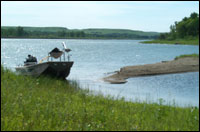
Region 8 includes land stretching from the Upper Missouri River …
What do I know about you, my readers? I assume I am “preaching to the choir” on the need for environmental protection. It is the mission of both the EPA and Grist to encourage you to care about your environment, and to be actively involved. So tune in for my sermon on Wednesday. I will be selling “taking care of your place” — and you will get a report card you can use to assess your involvement.
I have worked for the EPA in several programs (drinking water, Superfund, brownfields, and now watershed protection) since 1970. In the 70s, it was often necessary to explain what “EPA” stood for. That is rarely necessary now. There has been a tremendous and positive change in awareness and understanding of environmental issues, and support for working on those issues. But to achieve added advances in environmental quality, two major factors must be confronted: 1) while support for environmental protection has increased, that support wavers when other values (money, time, convenience) come into play; and 2) the more you clean up, the more complex and expensive it gets to clean up what remains. These factors are not going away, and with them comes the controversy that surrounds many issues. It makes the EPA an interesting place to work.
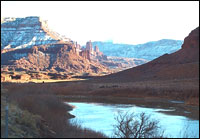
… to the canyons of Utah.
The EPA has the mission of protecting public health and the environment, which it pursues by implementing and overseeing a host of environmental laws. The EPA has 16,000 employees spread over a headquarters office, five research-oriented centers, and 10 regional offices. My Region 8 office covers six states: Colorado, Montana, North Dakota, South Dakota, Utah, and Wyoming. We have staff working on mine site cleanups, review of state air-quality programs, green building design, Endangered Species Act, wetlands planning and protection, enforcement of stormwater violations, forest project NEPA reviews, pesticide impacts on public health, assessment of watershed habitats, and too many others to list. Our roles vary and include technical support, education, community involvement, regulatory compliance, enforcement, and oversight of state agencies. This means I cannot begin to “represent” the EPA or cover the scope of what it does in this diary. Go to www.epa.gov and have at it.
There are positive and negative aspects of working for the EPA. There is always a lot going on; we are visible and in the news, and often both loved and hated for our efforts on the same issue. If you don’t like being in the middle or criticized or accused of playing “God,” you don’t want to work here. (I have only been threatened once, but have often contended with roomfuls of angry citizens.) If you want a streamlined decision-making process and satisfaction from quick, on-the-ground results, look elsewhere. The upside in EPA Region 8 is that there is a range of meaningful, complex, and interesting issues to work on. The majority of the staff is dedicated, competent, fun, and passionate about improving the environment. It is impossible to agree with every decision that is made at the EPA. I long ago ceased to feel accountable for all that the EPA works on.
Politics have a role in the EPA’s doings. It comes with the territory. You will not hear about the political side of working for the EPA during these five days, though. Sorry — I hope you understand — but it is not appropriate for Grist diary entries.
My assignments revolve around support for watershed protection efforts, and particularly support of local watershed protection groups. My main duties are to support watershed protection activities in the Cherry Creek, Colo., watershed; support the Colorado Watershed Assembly in meeting needs of watershed groups across Colorado; oversee a large study of watershed restoration and volunteer projects by the Coalition for the Upper South Platte; coordinate EPA watershed activities for the Town of Rico, Colo.; and coach leaders of watershed groups on their leadership skills. As I am in the bureaucracy, my job revolves around the phone, email, and meetings — so I work in support of others and vicariously feel effective and satisfied.
The five other members of the Ecosystem Stewardship Team do similar things, in different places. Their skill sets are typically more technical than mine, whereas I am focused more on watershed organizational and leadership needs. We have recently added to our technical assessment and GIS skills.
My coaching of watershed group leaders has evolved from concentrating on the organizational needs of watershed groups. I came to realize that the sustainability of groups is related to the strength of their leadership. Leadership of a watershed group demands technical, facilitation, organizational, fundraising, and leadership skills. Last year, I proposed to support group leaders through “coaching” them to strengthen their organizations and their leadership skills. Coaching in this context means helping the “client” in identifying and pursuing their own goals. I am now working with several group leaders, with regular sessions by phone — five this past week. This helps me to keep in touch with the needs of groups, and feel valuable. My managers have been incredibly supportive of this activity.
One thing that really keeps me going is watershed group events. I attended the Montana Watershed Symposium in balmy Great Falls in December with 250 others. I had the opportunity to get to know several local group leaders, and there were several speakers who elaborated on the watershed movement’s historical and natural resource significance. As Dan Kemmis said, “something is going on” with the watershed movement. I am inspired by the good work going on, and thankful I get to support it.
Tuesday, 20 Jan 2004
DENVER, Colo.
I live in the Troublesome Gulch watershed. It helps one’s sense of place to identify with the watershed you live in.

Trisecting for flow measurement and channel geometry in a Rocky Mountain headwaters stream.
A watershed is the area draining to a common stream, lake, or other body of water. Factoid: The Western explorer John Wesley Powell supported the formation of local governments based on watersheds. It made sense in Powell’s mid-19th century America — and it still does. But if he had a marketing strategy for this plan, it was a total failure.
I work with several watershed groups in Colorado on their water-quality monitoring. I am a liaison between our laboratory and groups who use our lab for microbiological analyses. Recently, I organized a discussion for one group on “toxic algae” in their source water — and potentially in their water supply. In another case, I am coordinating between a watershed group and our lab on macroinvertebrate (“bug”) sampling.
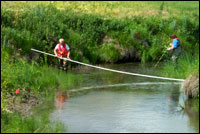
Taking physical channel measurements in a South Dakota stream.
Much of my focus and expertise is used to help groups with their finances. Today, I am assisting the town of Rico, Colo., and the Willow Creek Reclamation Committee in assessing how they might finance their projects and organizations. Financing for these groups ranges from classic nonprofit fundraising to competing for government grants.
Local watershed groups vary dramatically in their objectives, structure, area of coverage, and partnering. They work on scales ranging from a few square miles to thousands. Watershed groups typically bring together diverse local stakeholders to improve communication and collaborative decision-making, and to educate local residents. They are often involved in restoration projects to improve water quality, and they also commonly address fishery, recreational-boating, and environmental issues. A group often begins with volunteer staff and develops the capacity to bring on a paid coordinator. Whereas water quality was initially the main issue for most groups, incorporation of water supply stakeholders is becoming more prevalent, increasing involvement in key watershed issues.
While the EPA is responsible for regulating and enforcing water-quality laws, we also support the “watershed approach” as a strategy for communities to protect and restore aquatic ecosystems and protect human health. The premise is that many water-quality and ecosystem problems are best solved at the watershed level rather than at individual stream or polluter levels.
The EPA’s support of the watershed approach is based on the following factors: 1) local watershed groups, when armed with good information, can often accomplish more to improve water quality than regulatory approaches; 2) many water-quality challenges fall outside of existing regulatory mandates; and 3) solutions developed and embraced by local residents often have the most enduring success. Watershed groups also contribute to increased local leadership, stewardship, participation, and understanding of the issues. According to River Network, there are currently more than 4,000 watershed groups in the U.S. The emergence of these groups is a significant development in the history of citizen participation as a means of protecting our natural resources. Watershed groups confront a wide array of technical, financial, and organizational hurdles, and it is rare for a group coordinator to be skilled in all of these areas. In my support role for these groups, I provide information, advice, coordination, advocacy, and networking. I do most of my work in Colorado and Montana, either with a group itself or with statewide umbrella organizations. My background allows me to be comfortable discussing organizational and partnering issues and providing advice on keeping a group sustainable. I also share knowledge about financial planning, obtaining resources (especially grants) from a wide variety of sources, and the general Clean Water Act regulatory process. My experience has also given me some expertise in managing the impacts of population growth on water resources. I am a generalist who knows a little about a lot. In technical matters of stream restoration or water-quality monitoring, I almost always need to refer people elsewhere.
As an example, I have been involved in the National Watershed Health Project since its inception in 2002. Watershed groups often struggle organizationally and financially. This project will provide groups with direct support in assessing their priorities and developing an action plan to improve. This past week, I have been an intermediary with several Colorado groups (San Miguel, Cherry Creek, Boulder Creek) to discuss the benefits of participating.
From my perspective, environmental protection has evolved away from the original Clean Water Act and other statutory “command and control” approaches wherein the feds and states mandated requirements and locals attempted to comply. Instead, communities have developed the capability to identify their own environmental issues and how they want to address them. Watershed groups have emerged as an effective way for local communities to address important water, land, and even recreation issues. The watershed approach to local water management is an excellent example of doing the right thing (protecting a community’s natural resources) in the right way (a community-based collaborative approach).
I feel fortunate to be supporting and promoting these efforts. My feelings are accentuated when I work directly with watershed groups, as they believe in what they do. One group leader recently described her role as that of a missionary teaching others to care about the place where they live. Local, state, and national watershed meetings inspire me with a sense of passion, fervor, and enjoyment of my work. Just in 2003, I have seen a similar passion expressed across the country: the River Rally in Skamania, Wash.; the Colorado Watershed Assembly; the Cherry Creek Conference; and the Montana Watershed Symposium.
I get to help these true believers. That is why I like my job.
Wednesday, 21 Jan 2004
DENVER, Colo.
Yesterday I traveled with EPA and state staff to Dove Creek, Colo. We met with the Dolores County commissioners to discuss our activities in Rico — a very small town in southwest Colorado. Most of the discussion was about the need for cleanup of high levels of leaded soil in citizens’ yards, leftover from the region’s hard-rock mining era. My assignment in Rico is to assist the town with their watershed needs, so I was not on the hot seat. Rico has asked for our help with coordination, planning, and finance needs for stream corridor restoration, water supply development, and sewer and wastewater treatment — I am getting up to speed on my new role. To do that, I have to talk to a lot of people in the Rico area, in the state government, and at the EPA. You’ll hear more about Rico on Friday. This is sermon day. You were warned. Today, you have the opportunity to examine your active support for the environment, complete a report card, and commit to doing more.
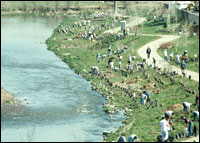
Volunteers planting along the South Platte in Denver.
To get to the point: Many people say they care about the environment, but that mostly entails passive interest, not active participation. Am I challenging the Grist diary readers? Yes. I am asking you to examine your behavior, and to do more. If you are actively engaged, congratulations to you — and thanks.
The EPA supports “community-based environmental protection” (CBEP), defined as “action that local individuals and groups take to address their own environmental concerns.” Most of my time is directly or indirectly spent in support of local groups, and they want to connect better with you. What better way to spend a diary day on CBEP than to influence you to be more locally committed?
To expand on what I said yesterday, public understanding and awareness of environmental issues has advanced significantly over the past 25 years. Most people under the age of 35 have been exposed to basic environmental education. Civic environmentalism has increased — but there is a huge need for more.

Denver residents celebrate closing a street to make way for a riparian park.
We are not seeing ever-increasing citizen participation, but we should be. I think we are waiting for someone else to do the work. We are at the level of protection where local decision-makers often rank the environment below other priorities.
Why do we need more personal commitment? What obligation do we have to the environment?
The obvious and easiest environmental gains have been made. What remains is more complex and expensive, or requires huge lifestyle changes. You live here and use the place; you have a moral obligation to take care of it. Colorado, where I live and do most of my work, is an excellent example. We have major air, water-quality, open space, and fishery issues, surface water and groundwater shortages, etc. — due to growth and lack of care and attention. Variations on these issues exist everywhere in the U.S. Environmental interests need a stronger and more organized voice, starting at the local level, as they are in huge competition with our growth, economic, and natural resource demands. That is why you are needed!
- Choose an issue: water, air, land use, hazardous waste, recycling, or wildlife. What’s important to you, an issue where you live, a recreational hobby or passion? What do you know, or care most about?
- Choose a level: local, state, or national. What level does your issue and sense of place take you to? Is there a group where you feel like you can make a difference?
- Choose an approach: collaboration or advocacy. Does the group adopt specific positions, or does it get many interests together and decide how to work together? Both are very valuable.
- Find a role: What does the group need to make a difference? Money? Awareness? Political involvement? General volunteers? Where can you make a contribution? What are your strengths? Do you have skills in finance, accounting, education, fundraising, or science?
Specific examples of statewide and local groups in Colorado include Chatfield Basin Conservation Network, Colorado Water Trust, Mesa County Land Conservancy, Colorado Watershed Assembly, Colorado Wildlife Federation, Trust for Land Restoration, Colorado Clean Water Action, and Three Lakes Watershed Association. I don’t have space to list more. You get the picture. All of them need your help.
Changing the ways we live as individuals is essential to improving our environment.
All environmental groups need your support. They need your money and your time. Contribute. Volunteer. Be on the staff. Lead! The work of these groups is essential to the well-being of your environment.
I developed this self-rating report card as a tool for you to assess your involvement. We all have our own expectations, priorities, and constraints.
- How would I rate my active involvement in environmental causes?
- How many hours per month do I devote to active involvement?
- How much of my net income do I donate annually to environmental causes?
- Did my involvement increase from 2002 to 2003? If not, why not?
- What are the obstacles to my increased involvement?
- How could I increase my involvement in 2004? More volunteering, perhaps in a leadership role? Contributions to environmental organizations?
How did you feel about this? I hope that many of you were proud of your active support. If not, you can be upset at me for raising the issue, or you can do something about it. Your environment needs you. Are you in the choir or are you listening to it?
See ya tomorrow.
Thursday, 22 Jan 2004
DENVER, Colo.
Today I attended the executive committee meeting of the Cherry Creek Stewardship Partners at Cherry Creek State Park. The park is an outstanding setting in the midst of southeast Denver sprawl, and is a symbol of what the Partners are all about — preserving and restoring what is left of the Cherry Creek corridor and working to ensure that future growth treads as lightly as possible.
Working committees on open space and habitat, water quality, and education do the Partners’ work, but the executive committee is essential to overall success. The committee has members from the key Partners’ jurisdictions and organizations. We have become friends through our many interactions. A few words and phrases to describe today’s meeting: energetic, thrashing, champions, lumpers vs. splitters, tail-wagging, fiduciary, and never-ending conversation.
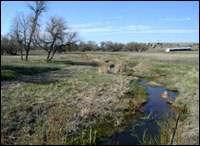
A Cherry Creek tributary upstream from urban development.
So what’s the point of writing about a committee meeting? My daily activities often focus on urban watersheds. For the past four years, 20 percent of my time has been focused on the Cherry Creek, Colo., watershed and the impacts of growth on water resources — today’s subject.
Summer 2002 was the lowest Colorado water-flow year ever recorded — a year of fire and drought. You probably remember. I gave an EPA headquarters visitor a tour of Cherry Creek. Normal late-summer flows were even lower than the normal 10 cubic feet per second. A major stream in the Denver metro area is only 20 feet across. I knew what we would be looking at. My visitor was totally floored at how little water we have.
In the West, low stream flows drive up the economic (and environmental) value of water. Where there is less water, the competition for available water becomes more intense, and the laws of supply and demand push the value way up. In recent years, population growth and drought in the West have made water a very valuable commodity.

The same tributary downstream from development.
Water is big news out here. The only beneficial aspect of drought and growth has been that media coverage of water issues has greatly increased awareness. Monday’s local headline was “Water Tap Fees Soar.” The Cherry Creek area has also had its share of media attention. A December 2003 series of articles highlighted the lack of water to support future growth in the South Metro area. More people means more of many other things. With urban watersheds, it often means more roads, roofs, driveways, and other impervious surfaces. This translates into more stormwater flow to the stream, especially during peak storms, and more erosion. And with lower stream base flows, the contaminants in stormwater have more of an impact on water quality. More people can also mean less of some things, like fish and groundwater. The Cherry Creek watershed begins 50 miles southwest of Denver and flows north through the Denver metro area. As a Western stream, it is small, with a typical discharge of 20 to 30 cfs into the South Platte River.
Recently, and fortunately, Cherry Creek also has more people working on its behalf. What I have seen from 2000 to 2004 is a great story, although the improvement of Cherry Creek is clearly a work in progress, with a long way to go.
During the ’90s, two counties in the upper Cherry Creek basin grew by more than 200,000 people — a 47 percent increase, with predictions of much more to come. Water quality impacts from phosphorus and other nutrients have had major impact on the valuable Cherry Creek Reservoir fishery. In 2000, there was a turning point when the Colorado Water Quality Control Commission directed the Cherry Creek Basin Water Quality Authority to refocus its efforts on reducing nutrient loads (i.e., phosphorus) into the reservoir to preserve the fishery. Also in 2000, Partners was just beginning to coalesce as a local watershed group.
Since that time, Partners has expanded to become a coordinating mechanism for water and riparian land activity in the watershed. The Basin Authority has done an excellent job of reorienting itself and lending support to the Partners — and vice versa.
A project that has helped to transform the situation is the Smart Growth for Clean Water project. Cherry Creek was one of five national pilots demonstrating approaches to growth that minimize impacts on water resources. Since mid-2001, this project has achieved several things, including a multi-jurisdictional agreement to protect Cherry Creek, a land conservation and protection strategy, and it has also greatly increased awareness of development impacts on Cherry Creek.
The Phosphorus Facilitator was designed to tackle inattention to natural resource protection among developers and local planners, and address resulting stream and water-quality issues. The PF will bridge issues between planners and developers by identifying the developers who are willing to develop in a more environmentally friendly way, facilitating the formulation of acceptable projects, and working with planning departments on code changes or incentives that will lead to improved developments. There were few examples of smart development, so the Partners and the Basin Authority had to “make it up” as they went — which was a risk and took persistence on their part.
There has been remarkable progress from the conception of these projects to the present. I attended last week’s Advisory Committee meeting which focused on the search for interested developers. Attracting developer attention can be difficult. The good news is that the developer response has been overwhelming.
My role at Cherry Creek is now mostly advisory. A tremendous amount of local capacity has been built since the Cherry Creek organizations were founded. When Partners began, I was involved in several organization-building aspects. At the beginning of the SGCW project, I led the effort — and it was a rocky road. Now I’m pleased to be watching and pitching in my two cents’ worth.
This recent success does not mean smooth sailing in the future. Just preserving the status quo in the face of continued development is a major challenge, and it requires long-term persistence and commitment on the part of all Partners who wish to see Cherry Creek retain its natural beauty. The residents of the Basin need to become Partners. The sun will come up tomorrow, and will bring more people and more challenges.
I ended my day by revising a proposal under our Land Revitalization Initiative, which integrates the work of several EPA programs. The proposal supports planning and financing of community activities under these programs for a specific community. It is common for me to work on projects for which policy decisions need to be made prior to public involvement. This is one of those projects.
Friday, 23 Jan 2004
DENVER, Colo.
Well, this is my final chapter. Words cannot describe … ah, forget it.
In this installment, called “EPA Potpourri Day,” I will cover EPA topics that are not my direct assignment. (Inquisitive minds can go to EPA.gov for more.)

Central Rockies Reservoir drawn down due to drought.
On the sustainability front, Environmental Management Systems are commonly defined as systems in which organizations catalog their various impacts on Mother Earth and make a plan to tread more lightly. Tim Rehder was recently assigned to the new position of EPA Region 8 EMS coordinator. I interviewed Tim in preparation for writing this diary entry, so I am plagiarizing his thoughts. He said it was OK. He claims none of them are original.
The EPA houses most of its employees in typical offices, so significant impacts result from 700-plus employees in an office consuming electricity, paper, and various other office products, traveling to meetings and inspections, and commuting. We also have laboratories that use lots of energy and create chemical wastes.
EPA Region 8 has a major EMS opportunity on the horizon, as we will be constructing a new downtown Denver building with a projected move date in 2006. The new building will be situated next to a major transit hub to encourage non-car commuting. Developers’ proposals will be graded on their use of features such as whole systems design, renewable energy (solar has huge potential in sunny Denver), secure bicycle parking, natural light, low-water landscaping, recycled materials, quickly renewing materials like bamboo and hemp, and low-toxicity paints. Tim thinks we’ll get a building that will make us proud, but he secretly worries the new building won’t have a Starbucks.
Given the EPA’s mission to protect public health and the environment, you couldn’t be blamed for thinking the EPA has an obligation to be a role model for organizations and to lead by example. There’s no doubt that most EPA employees have a strong environmental ethic. However, they are also Americans — the products of a remarkably wasteful, convenience-oriented culture. So Tim and his colleagues are constantly struggling to get employees to recycle, make two-sided copies, use energy-saving software, turn off computers and lights, and commute via mass transit or bicycle.
“For God’s sake, if we can’t get people at the EPA to act like the planet is in jeopardy, we’re screwed,” laments Tim. We must do better.
Personal interests gave me reason to chat with David Schaller of our staff, creator of the Sustainability Newsletter. Each weekly edition has two or three items on subjects as diverse as “International Momentum Builds to Ban Plastic Bags,” “Toyota Unveils First-in-the-World Ecological Vehicle Assessment System,” “Navdanya Helps Create Freedom Zones for Indian Farmers,” and “Chicago Climate Exchange Announces Start of Trading.” The emailed newsletter is distributed to 400 people in 11 countries, and is an outstanding electronic information transfer vehicle. David also inspires by including quotes from others in each edition, like, “Yes it is impossible, therefore it will take a little longer.” That quote seems pertinent to the EPA and its EMS attempts.
Just before lunch today, Nat Miullo and I met to discuss our efforts in the San Juan Mountain headwaters in southwest Colorado. We have an initiative providing ecosystem assessment services and assisting the watershed groups in the area, several of which suffer from the legacy of hard-rock mining. When we undertake an effort such as this, the required internal EPA, state, and local coordination is massive and difficult to streamline. Nat is helping by assessing how we are doing and offering suggestions.
For lunch today, I went out with a friend from my 1989 leadership program who is half of a small facilitation services firm. Dennis and I traded old stories, chatted about where our lives are going, and planned a larger leadership alumni lunch. It was fun, as we share many interests.
My boss suggested that I write a diary entry on the subject of EPA-state-local partnerships. How we work with states and locals is a factor in almost everything that the EPA does. All major environmental laws describe a state role that varies widely. We work closely with all six Region 8 states. Local governments and other partners are closest to the issues. Politics come into play often.
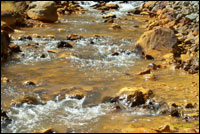
Old mining impacts have impaired many miles of Rocky Mountain headwater streams.
I will describe how this works in relation to Rico, Colo., and the Clean Water Act and Superfund. Rico is the small mining town we are working with in regard to old mining waste. Under the Clean Water Act, the state of Colorado has primary responsibility to set water-quality standards and issue discharge permits. The state is currently working on a water-quality assessment to provide the technical basis for issuing a permit for the St. Louis Tunnel Discharge just upstream from Rico. The EPA also has Clean Water Act enforcement “over file” authority. Several years ago, we filed suit against the St. Louis Tunnel owner for discharge permit violations, and are just now settling. With this amount of activity, a high level of federal-state-local communication is necessary, and issues exist with the tunnel — so not everyone is happy.
In my role as a watershed coordinator, I advocate non-regulatory, locally based voluntary approaches to resolving water-quality and habitat issues. While I think it is the right thing to do, it interjects another level of complexity but also adds opportunities for solutions.
For abandoned hazardous-waste sites, Superfund plays out in a different way. EPA has direct responsibility to designate Superfund National Priority List (NPL) sites (a designation used to indicate high-priority sites and to ensure adequate cleanup); states are in a support role. So we relate to each other very differently under Superfund versus the Clean Water Act. Under Superfund, we are the lead agency with the goal of minimizing the health risks of lead (the metal) in Rico’s residential soils. There are several cleanup options (Superfund emergency removal, voluntary cleanup, Superfund NPL designation). Rico and its residents have strong opinions, as they should. I am helping plan for a Feb. 11 public meeting intended to gather community concerns regarding the options for cleanup. The details are way more complex and confusing than this. Is it surprising we have communication issues?
So my Grist diaries end. I have chosen to provide background on what I do, versus snippets; I hope that has kept your interest. Remember: I am from the government, and it’s your job and mine to take care of the planet.

